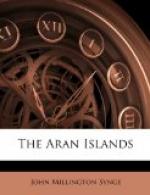‘And what do you think he did then?’ he continued; ’he wrote a book of his own stories after making that lot of money with mine. And he brought them out, and the divil a half-penny did he get for them. Would you believe that?’
Afterwards he told me how one of his children had been taken by the fairies.
One day a neighbor was passing, and she said, when she saw it on the road, ‘That’s a fine child.’
Its mother tried to say ‘God bless it,’ but something choked the words in her throat.
A while later they found a wound on its neck, and for three nights the house was filled with noises.
‘I never wear a shirt at night,’ he said, ’but I got up out of my bed, all naked as I was, when I heard the noises in the house, and lighted a light, but there was nothing in it.’
Then a dummy came and made signs of hammering nails in a coffin. The next day the seed potatoes were full of blood, and the child told his mother that he was going to America.
That night it died, and ‘Believe me,’ said the old man, ’the fairies were in it.’
When he went away, a little bare-footed girl was sent up with turf and the bellows to make a fire that would last for the evening.
She was shy, yet eager to talk, and told me that she had good spoken Irish, and was learning to read it in the school, and that she had been twice to Galway, though there are many grown women in the place who have never set a foot upon the mainland.
The rain has cleared off, and I have had my first real introduction to the island and its people.
I went out through Killeany—the poorest village in Aranmor—to a long neck of sandhill that runs out into the sea towards the south-west. As I lay there on the grass the clouds lifted from the Connemara mountains and, for a moment, the green undulating foreground, backed in the distance by a mass of hills, reminded me of the country near Rome. Then the dun top-sail of a hooker swept above the edge of the sandhill and revealed the presence of the sea.
As I moved on a boy and a man came down from the next village to talk to me, and I found that here, at least, English was imperfectly understood. When I asked them if there were any trees in the island they held a hurried consultation in Gaelic, and then the man asked if ‘tree’ meant the same thing as ‘bush,’ for if so there were a few in sheltered hollows to the east.
They walked on with me to the sound which separates this island from Inishmaan—the middle island of the group—and showed me the roll from the Atlantic running up between two walls of cliff.
They told me that several men had stayed on Inishmaan to learn Irish, and the boy pointed out a line of hovels where they had lodged running like a belt of straw round the middle of the island. The place looked hardly fit for habitation. There was no green to be seen, and no sign of the people except these beehive-like roofs, and the outline of a Dun that stood out above them against the edge of the sky.




